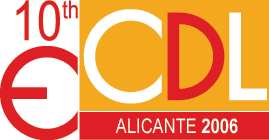
Thesauri and ontologies in digital libraries 1.
Structure and use in knowledge-basedassistance to users
Presenters' name:
Dagobert Soergel, College of Information Studies, Univ. of Maryland.
Abstract
This introductory tutorial is intended for anyone concerned with subject access to digitallibraries. It provides a bridge by presenting methods of subject access as treated in aninformation studies program for those coming to digital libraries from other fields. It willelucidate through examples the conceptual and vocabulary problems users face when searchingdigital libraries. It will then show how a well-structured thesaurus / ontology can be used as theknowledge base for an interface that can assist users with search topic clarification (for examplethrough browsing well-structured hierarchies and guided facet analysis) and with finding goodsearch terms (through query term mapping and query term expansion - synonyms and hierarchicinclusion). It will touch on cross-database and cross-language searching as natural extensions ofthese functions. It will also mention the use of more richly structured ontologies, includingSemantic Web applications. The tutorial will cover the thesaurus structure needed to supportthese functions: Concept-term relationships for vocabulary control and synonym expansion,conceptual structure (semantic analysis, facets, and hierarchy) for topic clarification andhierarchic query term expansion). It will introduce a few sample thesauri and ontologies andsome thesaurus-supported digital libraries and Web sites to illustrate these principles.
Contents
- Thesaurus functionsIntroduction
Challenges for digital libraries. Why thesauri: a first look with examples. User orientation in a concept space and vocabulary confusion (examples). What is a thesaurus? A first look with examples. Thesaurus functions.
- Thesaurus structure
Concept-term relationships. Conceptual structure: Semantic analysis and facets. Hierarchy. Implementing thesaurus functions.
- Evaluation of thesauri
Yahoo classification as an example.
- Resources
- Examples of classifications and thesauri
Alcohol and Other Drug Thesaurus (AOD Thesaurus). US National Institute on Alcohol Abuse and Alcoholism (NIAAA). Medical Subject Headings (MeSH) and Unified Medical Language System (UMLS). US National Library of Medicine (NLM). Art and Architecture Thesaurus (AAT). Getty Foundation. Dewey Decimal Classification. US Library of Congress & OCLC/Forest Pr. WordNet. Princeton University, George Miller. CYC Ontolog.
Copyright ECDL - Design by JASBAT
